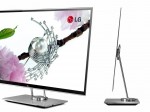OLED TVs: How Will They Affect the Market?
 Current HDTV technology has just about peeked. LCD TVs are about as affordable as they’re going to get before slowly disappearing from the market completely, and LED sets are nearly out of room for any more “value-added features.” High-end plasmas are still the top choice for anyone who wants the upmost image quality, no matter the cost, but they’re about to see some heavy competition.
Current HDTV technology has just about peeked. LCD TVs are about as affordable as they’re going to get before slowly disappearing from the market completely, and LED sets are nearly out of room for any more “value-added features.” High-end plasmas are still the top choice for anyone who wants the upmost image quality, no matter the cost, but they’re about to see some heavy competition.
Samsung and LG both demoed their upcoming OLED HDTV sets at CES 2012 earlier this year, and it’s a safe bet that we’ll see several OLED sets hitting the market before the year is up. What remains to be seen is how the entry of OLED TVs into the market will affect things.
What is OLED?
OLED screens combine the picture quality benefits of plasma with the space and power saving technology of LED. To better understand how an OLED screen works, let’s take a look at how traditional displays technology works.
 TVs today use some sort of a backlight in order to illuminate an image on the screen. LCD screens have a CCFL (cold-cathode fluorescent lamp) in the edge of the display; edge-lit LED displays work similarly but use LED lights instead of the CCFLs. Backlit LED displays use a grid of LED lights directly behind the display, allowing it to adjust the brightness in specific sections. In a plasma display, ever pixel is made up of several champers of phosphorus gas that illuminates when charged; in other words, each pixel gives off its own light, with no need for a backlight, which is what allows for those deep blacks.
TVs today use some sort of a backlight in order to illuminate an image on the screen. LCD screens have a CCFL (cold-cathode fluorescent lamp) in the edge of the display; edge-lit LED displays work similarly but use LED lights instead of the CCFLs. Backlit LED displays use a grid of LED lights directly behind the display, allowing it to adjust the brightness in specific sections. In a plasma display, ever pixel is made up of several champers of phosphorus gas that illuminates when charged; in other words, each pixel gives off its own light, with no need for a backlight, which is what allows for those deep blacks.
OLED displays work in the same sense as a plasma screen, in that each pixel is capable of emitting its own light. Alternatively, OLEDs are much more power-efficient and smaller than the plasma gas chambers needed for a plasma display. The end result is a super slim display with stunning color quality and perfect black levels that’s even energy efficient.
How Will OLEDs Affect Plasmas
Because the focus of new OLED displays will be picture quality, the high-end plasmas that videophiles flock to will be most affected. The most expensive plasma screens might see some price drops in order to compete with the superior OLED displays, but the entry and mid-range plasmas, like our current top-rated Panasonic TX-P VT30, should be fairly unaffected, at least for a year or two.
What about LED TVs?
Large LED TVs will also see some heavy competition from OLEDs since it’s expected that the first OLED sets to hit the market will be in the 55- to 70-inch range. Price will be the big deciding factor here. OLEDs will best traditional LED TVs in basically all categories, but they will be considerably more expensive. Samsung’s ES8000 series, Sony’s Bravia XBR series, and other “premium” models might see some considerable price drops when OLED TVs hit the market. Smaller, less feature-packed sets, like Sony’s KDL EX720 line, will be less affected.
And the LCD TVs?
LCD screens will remain the go-to flat panel TVs for anyone on a budget. It won’t be until a few years from now when OLED sets start challenging the prices of similarly sized LED TVs that we see the LCD sets start to fade from the market.
OLED TVs are a great advancement to HDTV technology, and they really will outperform any display currently on the market. If you’re in the market for a new TV today, is it work waiting for an OLED model to hit the market? Definitely! But only if you’re planning on spending upwards of $5,000 on something truly top-end.



